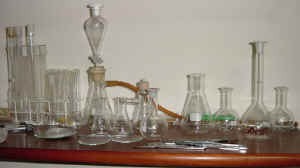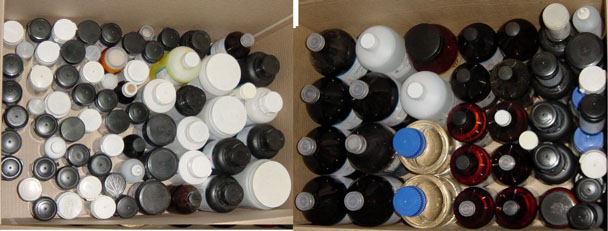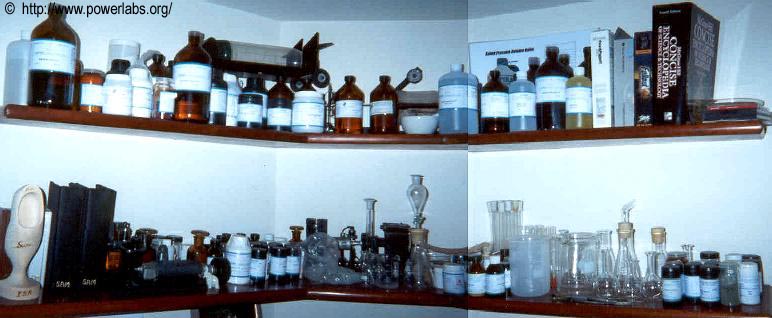Sam Barros' ChemLabs! |
 |
Introduction: |
|||||||||||||||||||||||||||||||||||||||||||||||||||||||||||||||||||||||||||||||||||||||||||||||||||||||||||||||||||||||||||||||||||||||||||||||||||||||||||||||||||||||||||||||||||||||||||||||||||||||||||||
|
Chemistry in action! ChemLabs is Sam Barros' PowerLabs chemistry division. Whilst PowerLabs mostly deals with electronics, mechanics, physics and engineering on a practical aspect, ChemLabs focuses almost entirely on the practical aspects of chemistry. At some point in time ChemLabs was a fully equipped laboratory with over 150 analytical grade reactants and various pieces of specialized lab glassware and equipment available, suitable for performing almost any conceivable non-industrial chemical procedure or synthesis. The laboratory described here was my second chemical lab (the first one was located in Holland and didn't have a fraction of what this one had) and was assembled over a period of approximately one year, during which a couple thousand dollars was invested in every obtainable reagent as well as all the equipment required to handle those reagents, and a couple hundred hours went into using these reagents to synthesize reagents which could not be obtained: This was the case for all the Perchlorates, Nitrates (except NaNO3), Chlorates (except NaClO3), paraformaldehyde, Hexamine, Styphnic and Picric Acid, and others, although the more hazardous chemicals were only synthesized when needed, so as to reduce any danger associated with storing unstable chemicals. This page continues to be updated as time permits: several other experiments still need a write-up. Please note the following: PowerLabs does NOT sell any type of chemicals, or distribute any information about these topics aside from what is made available here. |
|||||||||||||||||||||||||||||||||||||||||||||||||||||||||||||||||||||||||||||||||||||||||||||||||||||||||||||||||||||||||||||||||||||||||||||||||||||||||||||||||||||||||||||||||||||||||||||||||||||||||||||
|
|
|||||||||||||||||||||||||||||||||||||||||||||||||||||||||||||||||||||||||||||||||||||||||||||||||||||||||||||||||||||||||||||||||||||||||||||||||||||||||||||||||||||||||||||||||||||||||||||||||||||||||||||
Mission Statement: |
|||||||||||||||||||||||||||||||||||||||||||||||||||||||||||||||||||||||||||||||||||||||||||||||||||||||||||||||||||||||||||||||||||||||||||||||||||||||||||||||||||||||||||||||||||||||||||||||||||||||||||||
|
ChemLabs' main purpose
is to supply the means of carrying out all of PowerLabs' chemical procedure
needs. It has served for electroplating, metal etching, fuel production
/ oxidizer production, and others. ChemLabs plays a key role in all of PowerLabs'
rocket research, plasma research, is used to produce fuel for my model planes,
and has been in the past used for energetics research. |
|||||||||||||||||||||||||||||||||||||||||||||||||||||||||||||||||||||||||||||||||||||||||||||||||||||||||||||||||||||||||||||||||||||||||||||||||||||||||||||||||||||||||||||||||||||||||||||||||||||||||||||
|
|
|||||||||||||||||||||||||||||||||||||||||||||||||||||||||||||||||||||||||||||||||||||||||||||||||||||||||||||||||||||||||||||||||||||||||||||||||||||||||||||||||||||||||||||||||||||||||||||||||||||||||||||
ChemLabs Demos:Note: please be aware that the procedures listed here are only a rough draft. Only successful procedures are listed; synthesis that did not work or failed to synthesize the desired chemical are not provided. |
|||||||||||||||||||||||||||||||||||||||||||||||||||||||||||||||||||||||||||||||||||||||||||||||||||||||||||||||||||||||||||||||||||||||||||||||||||||||||||||||||||||||||||||||||||||||||||||||||||||||||||||
Nitrocellulose
synthesis: From varnishes to plastics, rocket fuels and explosives,
a full illustrated procedure outlining the different forms of nitration
to produce this very useful industrial product. Included are videos of two
different forms of NC deflagrating.
Mercury,
Silver and Copper Fulminate synthesis: Some of the earliest explosives
ever discovered, fulminates detonate violently on flame, impact, or friction,
even unconfined. Videos available, as well as further information on more
exotic (gold, platinum, double) fulminates.
PowerLabs
overview of Deflagrating chemicals, and Potassium Bromate oxidizer
demo: A very powerful deflagrating compound is produced with
KBrO3 to demonstrate its oxidizing powers. It burns faster than blackpowder
when initiated by a drop of sulphuric acid (video). |
|||||||||||||||||||||||||||||||||||||||||||||||||||||||||||||||||||||||||||||||||||||||||||||||||||||||||||||||||||||||||||||||||||||||||||||||||||||||||||||||||||||||||||||||||||||||||||||||||||||||||||||
|
|
|||||||||||||||||||||||||||||||||||||||||||||||||||||||||||||||||||||||||||||||||||||||||||||||||||||||||||||||||||||||||||||||||||||||||||||||||||||||||||||||||||||||||||||||||||||||||||||||||||||||||||||
Chemlabs Supplies: |
|||||||||||||||||||||||||||||||||||||||||||||||||||||||||||||||||||||||||||||||||||||||||||||||||||||||||||||||||||||||||||||||||||||||||||||||||||||||||||||||||||||||||||||||||||||||||||||||||||||||||||||
|
Others:
Potassium Chloride (KCl) 99.5% 300g |
|||||||||||||||||||||||||||||||||||||||||||||||||||||||||||||||||||||||||||||||||||||||||||||||||||||||||||||||||||||||||||||||||||||||||||||||||||||||||||||||||||||||||||||||||||||||||||||||||||||||||||||
|
My Favorite Chemistry Site: Delights of Chemistry.
|
|
Copyright (c) 1999 - 2009
by Sam Barros. All rights reserved. Removing any material from this site for display without consent from its author consists in an infringement of international copyright laws and can result in fines up to $50000 per infringement, plus legal costs. So ASK ME before you remove anything from here. |
 ChemLabs had the following reactants at its disposal. Notice how no inherently
unstable materials are stored; this is vitally important; even in industrial
laboratories terrible accidents have happened and continue to happen due
to the storage of energetic materials and such accidents are even more common
in home laboratories. The only way to ensure that an unstable compound
does not explode in storage is to not store it in the first place. With
the reactants below it is possible by acid/base neutralization or nucleophilic
substitution to produce virtually any fluoride/chloride/phosphate/sulphate/nitrate/acetylide/fulminate/fuel-oxidizer
deflagrant mixture, as needed. It is also possible to produce many other
chemicals using the ones outlined below as a starting base (in fact several
of the chemicals below were produced in such a way).
ChemLabs had the following reactants at its disposal. Notice how no inherently
unstable materials are stored; this is vitally important; even in industrial
laboratories terrible accidents have happened and continue to happen due
to the storage of energetic materials and such accidents are even more common
in home laboratories. The only way to ensure that an unstable compound
does not explode in storage is to not store it in the first place. With
the reactants below it is possible by acid/base neutralization or nucleophilic
substitution to produce virtually any fluoride/chloride/phosphate/sulphate/nitrate/acetylide/fulminate/fuel-oxidizer
deflagrant mixture, as needed. It is also possible to produce many other
chemicals using the ones outlined below as a starting base (in fact several
of the chemicals below were produced in such a way).
 The more hazardous items are kept in a cupboard for added safety.
The acids and bases come in large bottles; the brown ones are for
light sensitive chemicals such as hydrogen peroxide and nitric acid,
and the large heat resistant 1L graduated Schott Duran for Sulphuric.
The smaller bottles (250, 100, and 50mL) contain chemicals that
are not used frequently, are very expensive, or are too hazardous
for mass storage (examples include mercury metal, sodium peroxide,
phosphoric acid, arsenic, etc). Oxidizers and solids in general
come in plastic bottles ranging from 25g to 1kilogram. The Hydrofluoric
and Perchloric acid, and the distilled water all come in Teflon
bottles. These feel like they are constantly covered in oil or butter,
due to the extremely low coefficient of friction of PTFE.
The more hazardous items are kept in a cupboard for added safety.
The acids and bases come in large bottles; the brown ones are for
light sensitive chemicals such as hydrogen peroxide and nitric acid,
and the large heat resistant 1L graduated Schott Duran for Sulphuric.
The smaller bottles (250, 100, and 50mL) contain chemicals that
are not used frequently, are very expensive, or are too hazardous
for mass storage (examples include mercury metal, sodium peroxide,
phosphoric acid, arsenic, etc). Oxidizers and solids in general
come in plastic bottles ranging from 25g to 1kilogram. The Hydrofluoric
and Perchloric acid, and the distilled water all come in Teflon
bottles. These feel like they are constantly covered in oil or butter,
due to the extremely low coefficient of friction of PTFE.
 Some of the more "advanced" equipment includes
a 0 - 360C thermostat controlled hotplate (300W), a 50cm long serpentine
glass condenser (both seen on the picture to the left, which show
a distillation apparatus set up for the distillation of Nitric Acid.
Not show in the apparatus is the venturi pump and vacuum line, which
was necessary for reduced pressure distillation). The picture to
the right shows a vacuum dissector. It consists in a 10L glass vessel
weighting over 15kilograms, containing 2 kilos of Silica Gel in
the bottom, and attached to a vacuum pump. A substance to be dried
is placed inside the dissector and a vacuum is pulled inside it
with the attached pump (in this picture a refrigerator pump is being
used. This worked reasonably well and could dry most things within
a couple of hours). As the water evaporates from the material it
becomes trapped in the silica gel. Once the silica has become saturated
(evidenced by it change of color from blue to pink, thanks to a
cobalt indicator added to it) it needs to be heated at 150C for
a couple of hours so it can once again perform its duty. This dissector
greatly increased the speed of the procedures in the lab, making
procedures that require multiple crystallizations take hours, as
opposed to days. It was found that Silica can absorb most solvents
almost as well as water, though it deteriorates quicker in doing
so.
Some of the more "advanced" equipment includes
a 0 - 360C thermostat controlled hotplate (300W), a 50cm long serpentine
glass condenser (both seen on the picture to the left, which show
a distillation apparatus set up for the distillation of Nitric Acid.
Not show in the apparatus is the venturi pump and vacuum line, which
was necessary for reduced pressure distillation). The picture to
the right shows a vacuum dissector. It consists in a 10L glass vessel
weighting over 15kilograms, containing 2 kilos of Silica Gel in
the bottom, and attached to a vacuum pump. A substance to be dried
is placed inside the dissector and a vacuum is pulled inside it
with the attached pump (in this picture a refrigerator pump is being
used. This worked reasonably well and could dry most things within
a couple of hours). As the water evaporates from the material it
becomes trapped in the silica gel. Once the silica has become saturated
(evidenced by it change of color from blue to pink, thanks to a
cobalt indicator added to it) it needs to be heated at 150C for
a couple of hours so it can once again perform its duty. This dissector
greatly increased the speed of the procedures in the lab, making
procedures that require multiple crystallizations take hours, as
opposed to days. It was found that Silica can absorb most solvents
almost as well as water, though it deteriorates quicker in doing
so. I was fortunate
enough to find someone to buy my chemicals once I moved out of Sao
Paulo and could not take them along with me to USA. Show to the
left are two of the six boxes in which they were put. The box to
the right contains fluorescein, and miscellaneous fuels. The box
to the right contains mostly acids, from which I can identify 9litres
of 99.8% analytical grade Sulphuric Acid, 10litres of 68% analytical
grade Nitric Acid, and a half kilogram bottle of Benzoyl Peroxide
(stabilized by the addition of 20% water). There are also some oxidizers
in the box.
I was fortunate
enough to find someone to buy my chemicals once I moved out of Sao
Paulo and could not take them along with me to USA. Show to the
left are two of the six boxes in which they were put. The box to
the right contains fluorescein, and miscellaneous fuels. The box
to the right contains mostly acids, from which I can identify 9litres
of 99.8% analytical grade Sulphuric Acid, 10litres of 68% analytical
grade Nitric Acid, and a half kilogram bottle of Benzoyl Peroxide
(stabilized by the addition of 20% water). There are also some oxidizers
in the box.